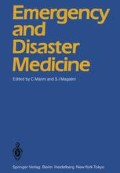Abstract
The fact that resuscitation of cerebral functions has become the central problem of modern reanimatology is apparently no longer questionable. Restoration of cardiac and respiratory activity and normalization of the affected metabolic functions are directed toward one common aim, namely, to prevent the brain from death, to help it get over the disorders which have emerged in the dying process. It is no mere chance that even ancient authors, mentioning three gates of death, spoke of the heart, lungs, and brain.
Access this chapter
Tax calculation will be finalised at checkout
Purchases are for personal use only
Preview
Unable to display preview. Download preview PDF.
References
Adrianov OS (1967) Conditioned reflex and structural organization of signal stimulus. Zh vysshey Nervnoy deyatel’nosti 17:847 –839
Adrianov OS, Popova NS (1963) On structural premises and functional features in the dynamics of nervous processes in visual, acoustic and cutaneous analyzers. Gagrskie besedy (Discussions in Gagry), vol 4. AS USSR Publishers, Tbilisi, pp 13–26
Adrianov OS (1976) On the principles of organization of integrative cerebral activity. Meditsina, Moscow
Gayevskaya MS, Grozdova TN (1952) The effect of pharmacological sleep on metabolic processes in cerebral cortex during dying and resuscitation of the organism’s vital functions. Biull Eksp Biol Med 34:39–43
Dusser de Barren J, Fulton J (1937) Functional localization in cerebral cortex. Biogiz, Moscow
Zarzhetskiy YV, Gurvitch AM (1979) Artificial pulmonary ventilation, special form of synchronized activity of the brain and its functional state at early stages of postreanimation period. Patol Fiziol 1:12–17
Zvorykin VP (1969) Reduction of the system of truncal formations in acoustic analyzer from the lowest monkeys towards man as a manifestation of further narrowing in the range of sounds perceived. Arkh Anat Gistol Embriol 57:37–46
Kirsanova AK, Mirotvorskaya GN, Mutuskina EA (1983) Influence of barbiturates on postresuscitation period after cardiac arrest in dogs. Anestheziol Reanimatol 3:39–42
Kulyabko AA (1902) Experience in resuscitation of heart. Izv Acad Sci 16:175–183
Mering TA (1967) Features of conditioned reflex connection closure. Acoustic analyzer. Meditsina, Moscow
Mikhailovsky IP (1925) Washing of blood in a living organism, its methods, problems and role in intoxication. Vrach Obozreniye 5:30–32
Molchanova LV, Pylova SI, Kozhura VL (1975) General regularities in disorders of protein metabolism in cerebral tissue in postreanimation conditions. Anesteziol Reanimatol 5:43–47
Negovsky VA (1943) Interrelations of breathing in animals dying from blood loss and at the subsequent period when the vital functions are reviving. Biull Eksp Biol Med 15:37–40
Pylova SI (1979) Posthypoxic disorders of protein metabolism in the cerebral tissue of animals which survived clinical death from acute hemorrhages. Special clin Physiol 4:240–264
Khananashvili MM (1962) Experimental investigation of visual function mechanisms. Medgiz, Leningrad
Chepov PM (1939) Lavage of a living organism through its circulatory system with removal of blood plasma and the prospects of using this method for man. Arkh Biol Nauk 59:43–52
Shikunova LG (1976) The role of postreanimation toxemia in pathogenesis of the resuscitated organism’s disease. In: Mechanisms of affections, resistance of adaptation and compensation. Meditsina, Tashkent, p 475
Alekseyeva GV (1980) Prevention and therapy of phychoneurological disorders in a distant postreanimation period. Anesteziol Reanimatol 8:70
Binnie CD, Prior PF, Lloyd DSL, Scott DF, Margerison JH (1970) Electroencephalographic prediction of fatal anoxic brain damage after resuscitation from cardiac arrest. Br Med J 4:265–268
Gayevskaya MS (1964) Biochemistry in the brain during the process of dying and resuscitation. Consultants’ Bureau, New York
Heraut LA, Lombert CH, Cathala HP (1980) Coma profond a frequence alpha apres pen-daison non suivie de mort immediate. Rev EEG Neurophysiol 10:21–32
Moller M (1978) Alpha-pattern coma and survival after cardiac arrest. Electroencephalogr Clin Neurophysiol 44:518 –522
Negovsky VA (1959) Pathophysiologie und Therapie der Agonie und des klinischen Todes. Akademie-Verlag, Berlin, pp 28–29
Editor information
Editors and Affiliations
Rights and permissions
Copyright information
© 1985 Springer-Verlag Berlin, Heidelberg
About this paper
Cite this paper
Negovsky, V.A. (1985). Neurological Aspects of Reanimatology. In: Manni, C., Magalini, S.I. (eds) Emergency and Disaster Medicine. Springer, Berlin, Heidelberg. https://doi.org/10.1007/978-3-642-69262-8_63
Download citation
DOI: https://doi.org/10.1007/978-3-642-69262-8_63
Publisher Name: Springer, Berlin, Heidelberg
Print ISBN: 978-3-642-69264-2
Online ISBN: 978-3-642-69262-8
eBook Packages: Springer Book Archive

